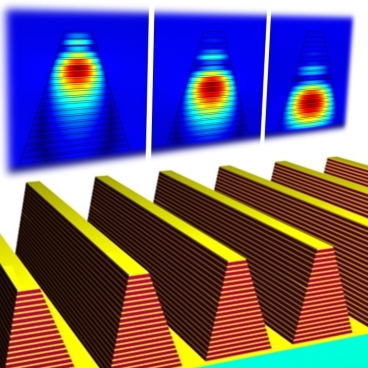Researchers from MIT have developed a new design for metamaterials, an innovative group of artificial substances, which can lead to the development of next generation optical sensors or solar cells.
 Tapered ridges, made from alternating layers of metal and insulating material deposited on a surface, can produce a metamaterial that is tuned to a range of specific frequencies of light.
Tapered ridges, made from alternating layers of metal and insulating material deposited on a surface, can produce a metamaterial that is tuned to a range of specific frequencies of light.
The design allows the materials to capture sunlight over a wide range with very high efficiency. The approach can have significant applications in light harvesting and thermal detection processes.
Nicholas X. Fang, Associate Professor in Engineering Design in MIT’s Department of Mechanical Engineering, stated that a large number of thin materials utilized to absorb light are restricted to a narrow range of angles of incidence and wavelengths. However, the new metamaterial design uses wedge-shaped ridges whose widths can be accurately tuned to capture light of a broad range of wavelengths and angles of incidence. These metamaterials can be very thin and save both weight and cost.
Researchers have designed a multilayer sawtooth structure that has an ability to absorb an extensive range of frequencies with over 95% efficiency. By employing the tuned metamaterial, the team was able to slow down the speed of light to below one-hundredth value. This resulted in trapping the light inside the material in an easier and effective manner. The metamaterials can be engineered using equipment in traditional photovoltaic-cell manufacturing process. Fang remarked that the material will act as an efficient absorber and emitter of photons and hence it is ideal for new types of infrared detectors or solar cells. In addition, it can be used in several infrared-light emitting applications, including devices for producing energy from heat.
The research work has received grants from the Asian Office of Aerospace Research and Development, the National Natural Science Foundation of China and the U.S. National Science Foundation.